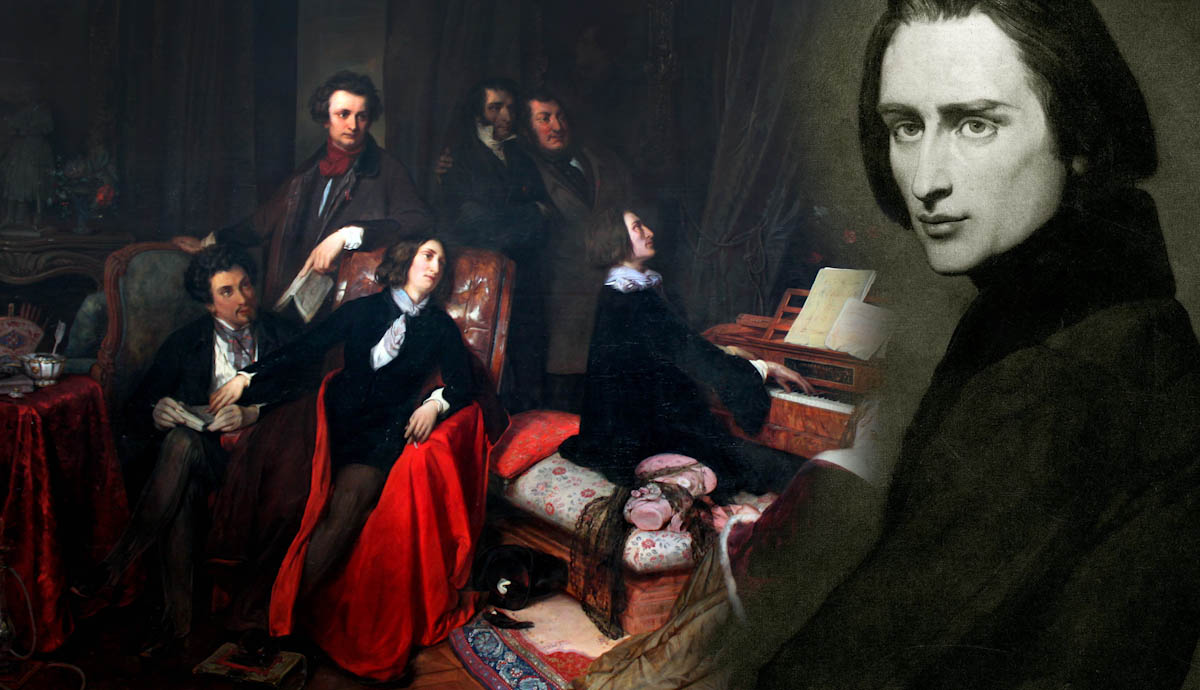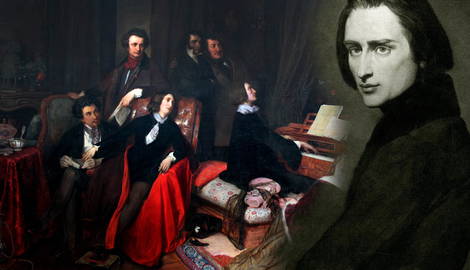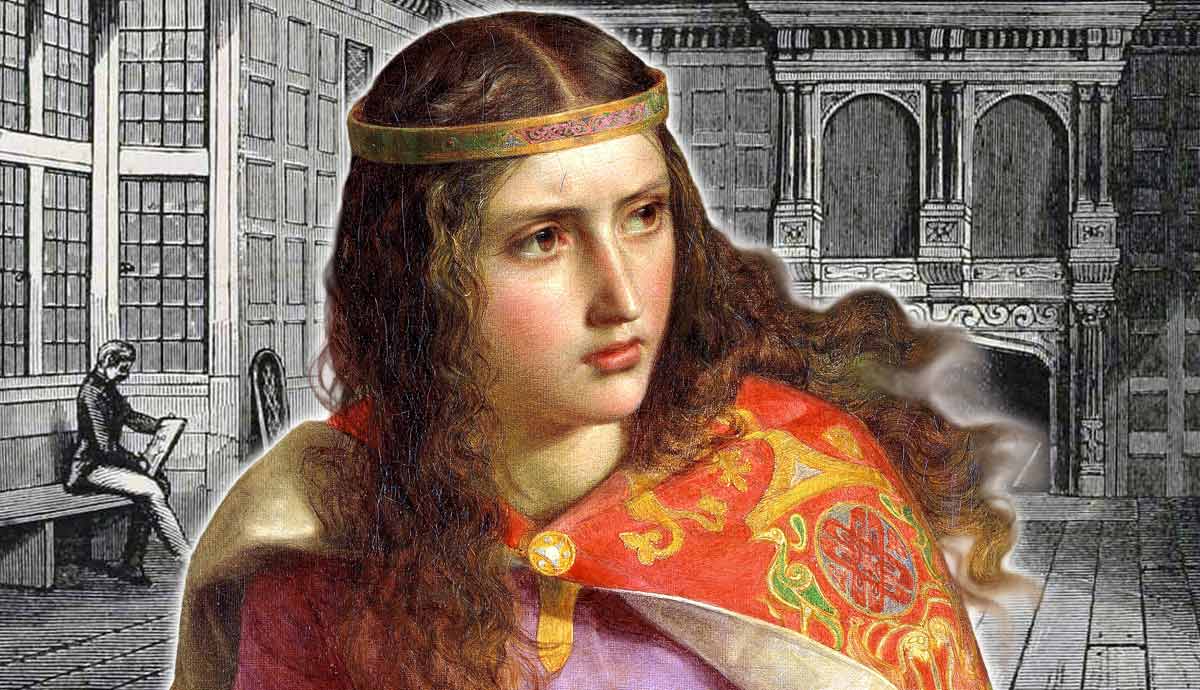
Riotous crowds, swooning fans, women jostling for a lock of hair. No, not a K-Pop or Beatles concert — this was Lisztomania. All the frenzy was for one man: Franz Liszt. As the virtuoso pianist tore through Europe, women from Paris to Berlin and Vienna went berserk for the young heartthrob. By 30, he had become an icon of the romantic music era. In this article, we’ll take a look at 4 things that contributed to Liszt’s level of fame.
Franz Liszt and Lisztomania

Quite rightly, Franz Liszt has been called the world’s first rock star. The glamorous pianist toured the breadth of Europe. Wherever he went, Franz Liszt inspired delirium in starstruck fans — mostly women.
Liszt had a habit of making female fans do some crazy things. Women reportedly fought over handkerchiefs Liszt had used, or crafted his broken piano strings into bracelets. Before there was “merch,” there were women pasting Liszt’s likeness onto their brooches and cameos. Packed crowds stole cuttings of his hair, his coffee dregs — even his cigar butts.
Concert halls were pandemonium. Articulating the craze in 1844, Heinrich Hein penned the term “Lisztomania.” He described it as a contagion in medical terms:
“And what is the real cause of this phenomenon?… A physician whose speciality is the disorders of women and with whom I conversed as to the magic which our Liszt exercises on his public, smiled mysteriously and told many things of magnetism, galvanism, electricity, of contagion in an overheated hall.”
Anecdotes aplenty tell us Franz Liszt had reached meteoric stardom. In the romantic music era, the modern celebrity was starting to take shape. No longer relying on wealthy patrons, Romantic poets and artists had to build a following to survive in the arts. But in music, Liszt was the first. So just what was it that made Franz Liszt so magnetic to so many at this time in history? Here are 4 reasons why Liszt was so adored by his fans.
1. Franz Liszt’s Scandalous Love Affairs

Young Franz Liszt had quite the reputation as a heartbreaker. In his 20s and 30s, he had a history of high-profile affairs with married noblewomen, which added to his allure. Most notably, there was the Countess Marie d’Agoult. 6 years Liszt’s senior, the Countess was intelligent, blue-blooded, and married — unhappily. What began as a fling with the dashing young composer turned serious when Marie fell pregnant.
In a hot scandal, the couple fled Paris for Switzerland. Here, they began a Bohemian life together, the Countess taking up writing while Liszt composed. Their cohabitation produced two more children, Marie all the while still married to her first husband.
The relationship did not last. By 1844, they had split, and Marie had returned to Paris. However, their longtime tryst did give Liszt a name. By the time his career as a performer was underway, he had risen from obscurity to public notoriety as a charmer who was unafraid to court scandal.

And he did it again. In 1847, Franz Liszt tickled the fancy of another noblewoman, the Polish Princess Carolyne von Sayn-Wittgenstein, who saw Liszt in concert. Sure, she was married. But that didn’t stop the couple from falling in love and living together. In vain, Carolyne sought an annulment from her first husband. Though her relationship with Liszt simmered down to a platonic friendship, the two were close companions for 40 years and beneficiaries in each other’s will.
Out of these two affairs with well-connected women — and many more mistresses — Franz Liszt became known as quite a Casanova. Gossip speculated about how many hearts (and beds) he had won. This reputation clearly added to the seductive quality of his performances.
2. Franz Liszt Was a Brilliant Virtuoso
Franz Liszt was a firecracker at the piano. His mesmerizing technical brilliance had not been seen before in the romantic music era. Crowds lapped it up. Between 1839 and 1848, Liszt had a brilliant career as a touring concert pianist. It is estimated that he performed over 1,000 solo concerts, an average of 3 or 4 a week. He toured Europe at an unprecedented scale, from Portugal, Ireland, Turkey, Romania, and Russia. His was a sheer, fiery talent.

Liszt had been blessed by nature. He had long hands and strong narrow fingers which could easily span a tenth and maneuver deftly around the keyboard. He had also learned from the best. Predicting Liszt to be a prodigy, his father had sent him for instruction by musical stalwarts, Czerny and Salieri.
His virtuoso style of playing was inspired by a legend of a totally different instrument: Paganini. After seeing the master violinist in concert, an enthralled Liszt strove to recreate the same miraculous prowess on the piano. So Franz Liszt composed with a purpose: to show off what he could do.
Some of his pieces were fiendishly difficult. Of Liszt’s 12 Grandes Études, for example, Schumann remarked that at most only 10 or 12 players alive could manage to play them. His technical passages bordered on the impossible. To Liszt, that was the point. He wanted to be a magician on stage, to captivate his audience by pushing the limits of his instrument.
His virtuoso style also threw the staid classical traditions into sharp relief. Gillen D’Arcy Wood writes about the virtuosophobia of the English aristocracy who turned up their noses at Liszt throughout the romantic music era. To them, sober playing was the pinnacle of art, and “showing off” was distasteful.
This was exactly why fans loved Liszt’s playing. Here was a young, dazzling pianist who broke free from the stodgy traditions of classical music. His concerts were thrilling.
3. Improvements In the Piano of the Romantic Music Era

None of this would have been possible without the right piano. Fortuitously, the piano was having a heyday in the romantic music era: enter the modern piano. The instrument’s design improved significantly in the first half of the 19th century, making Franz Liszt’s technical feats possible.
For one, the compass was expanded to 6½ octaves, widening the range of pitches. Past iterations of the piano had a limited sound quality. The harpsichord, for example, was sharp and pinching, and the 18th-century fortepiano was too soft to fill out large venues. Now, the piano’s thicker, durable strings gave it a more sonorous sound suitable for the concert hall. The addition of felt hammers also allowed for more subtleties within that sound.
Franz Liszt had access to this cutting-edge design. At 12, he was gifted with a grand piano with 7 octaves and double-escapement action. The instrument opened new musical possibilities for the composer to exploit.

He also explored new soundscapes. Especially in his transcriptions, Liszt’s works are known for imitating the different timbres of an orchestra. This distinct texture would not have been possible without the 19th century piano.
Still, he was ahead of his time. When performing in rural areas, Liszt sometimes had to make do with older pianos. Some even collapsed under his explosive technique.
4. Franz Liszt’s Theatrics

Franz Liszt was a showman. He loved spectacle and used it to keep his audience hooked. During his tours, Liszt pioneered the solo “recital,” even coining the term. Most of the conventions of the modern recital exist because of Liszt.
He was the first to play music from a range of periods (from Bach to Chopin), for example. He also lifted the piano lid to reverberate its sound through the hall and played entirely from memory. Unusually, his tours were also unaccompanied. Without even a page-turner, Liszt could completely occupy the full attention of the crowd.

Franz Liszt was also a fan of flamboyance. On stage, he would throw his white gloves to the ground before playing. He was never without his Hungarian sword and made a point of tossing around his signature shoulder-length hair during performances. Naturally, his pianos were turned sideways to show off his handsome profile to the crowd.
His repertoire also served this spectacle. Liszt spruced up works by Beethoven or Weber with extra runs, cadenzas, and presto tempi. In short, Franz Liszt could command a stage. He had star quality and knew it. His concerts were deliberately theatrical and made Liszt a larger-than-life celebrity.
Nevertheless, the piano of the romantic music era made it possible for Liszt to explode onto the scene in the way that he did. With its new depth of sound, the piano could be the center of attention in a recital — as could Liszt.
Franz Liszt, the True Original Heartthrob

Lisztomania is fascinating because it precipitated the rise of celebrity. Liszt made the way for the fandoms of Bieber, 1D and BTS. Today’s celebrity is highly constructed. Record labels manufacture stardom in a very calculated way. To an extent, Liszt also deliberately constructed his public image.
However, his fame spread organically thanks to factors outside his control. The tutelage of Salieri, better piano design, the newfound independence of 19th-century artists, and a public reacting against the stoicism of the upper class, all created the conditions in which a young and charismatic Franz Liszt could blow up.










